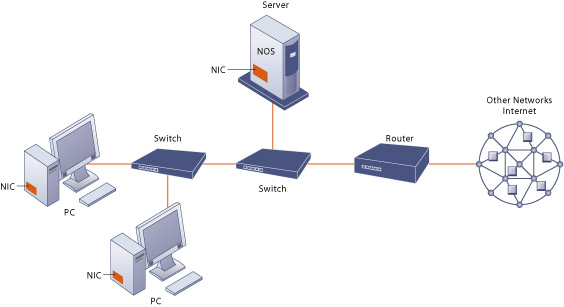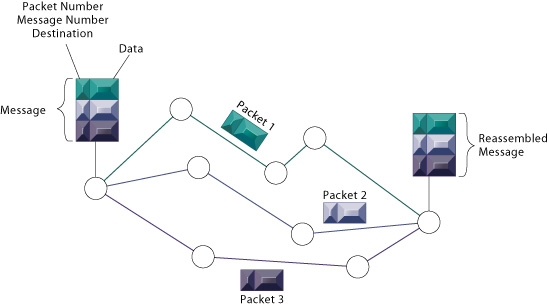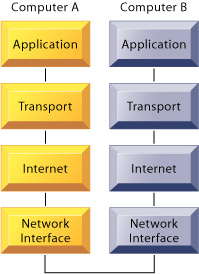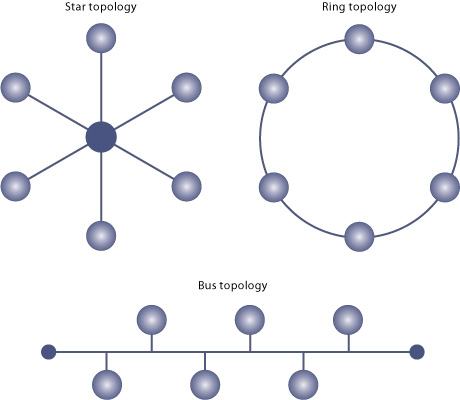| Section 8.2: Bullet Text |
Chapter
Contents | View
Full Text | View Bullet Text
|
Contemporary Networking Infrastructure
The major components used in a simple network include computers, network interface cards (NICs), a connection medium, network operating system (NOS) software, and a hub or switch. [Figure 8-4]
 |
FIGURE 8-4 Components of a simple network Illustrated here is a very simple network, consisting of computers, network operating system software, cable (wiring) to connect the devices, network interface cards, switches, and a router. In this illustration, the network operating system (NOS) resides on a dedicated server. |
The network operating system (NOS) manages communications on the network and coordinates network resources. Hubs are devices that connect network components, sending packets of data to all connected devices. Switches are like hubs but can forward data to specific destinations. Routers are communications processors used to route data through different networks.
Contemporary digital networks are based on three key technologies: Client/server computing, packet switching, and the use of communications protocols such as TCP/IP for linking disparate networks and computers.
In client/server computing, client computers are linked to each other through a network controlled by a server computer, which sets the rules of communication for the network and provides addresses for each client and device on the network.
Packet switching is a method of breaking messages into small packets that are sent independently along different paths in a network using a router and then reassembled at their destination. [Figure 8-5]
 |
FIGURE 8-5 Packed-switched networks and packet communications Data are grouped into small packets, which are transmitted independently over various communications channels and reassembled at their final destination. |
Protocols provide a set of rules to enable communication among diverse components in a telecommunications network. TCP/IP is a suite of protocols which has become the dominant model of achieving connectivity among different networks and computers and on the Internet, providing a method for breaking up messages into packets, routing them to the proper address, and reassembling them. The TCP/IP reference model has four layers. [Figure 8-6]
 |
FIGURE 8-6 The Transmission Control Protocol/Internet Protocol (TCP/IP) reference model This figure illustrates the four layers of the TCP/IP reference model for communications. |
Electronic signals in a telecommunications network can be analog or digital. A modem (abbreviated from MOdulation/ DEModulation) is a translating device that can convert signals from digital to analog and back. [Figure 8-7]
 |
FIGURE 8-7 Functions of the modem A modem is a device that translates digital signals from a computer into analog form so that they can be transmitted over analog telephone lines. The modem also is used to translate analog signals back into digital form for the receiving computer. |
Data is transmitted along physical transmission media, including twisted wire, coaxial cable, fiber optics, or wireless transmission. Twisted wire -- pairs of copper wires used mostly for analog voice signals but also sometimes for data -- is the oldest medium. Coaxial cable is thickly insulated wire that is faster and more interference-free than twisted wire. Fiber-optic cable consists of thousands of tiny clear glass fibers along which data is sent as pulses of light. Although primarily used as the high-speed network backbone, fiber optic is also being installed in homes and businesses. Telecommunications carriers use fiber optic to build purely optical networks to provide high-capacity transmission for multimedia, and other data-intensive information services. Optical networks boost capacity by using dense wavelength division multiplexing (DWDM) which enables the simultaneous transfer of multiple transmissions along a single channel. Wireless technology uses radio frequencies or infrared signals to transmit data wirelessly.
Telecommunications transmission speed is represented in bits per second (bps). The number of cycles per second a medium can send is called hertz; the capacity of the channel, measured as the difference between the highest and lowest frequencies it can transmit, is called bandwidth.
A local area network (LAN) is a telecommunications network that requires its own dedicated channels and also covers a limited distance, usually one building or several buildings in close proximity. Ethernet is the dominant LAN standard, specifying the physical transmission medium, access control rules, and a standardized frame, or set of bits, used to carry data. LANs may use a client/server architecture or a peer-to-peer architecture. LANs have different topologies, ways of connecting their components. The three major network topologies are the star, bus, and ring. A star network consists of a central hub connected directly to a number of other computers or terminals. All communications must travel through the host. A bus network links a number of computers by a single circuit; all signals are broadcast in both directions to the whole network, and software identifies which component is to receive a message. Bus networks fail less often and are often used for LANs. A ring network links all computers by a closed loop and passes data in one direction from one machine to another. [Figure 8-8]
 |
FIGURE 8-8 Network topologies The three basic network topologies are the bus, star, and ring. |
Wide-area networks (WANs) cover large geographical distances, even entire continents, or the globe, in the case of the most powerful WAN, the Internet. Metropolitan area networks (MANs) span a metropolitan area such as a city and its major suburbs.
A number of services are available to organizations requiring broadband, or high-speed transmission, capabilities or access to the Internet. Frame relay is cheaper and faster than packet switching because it does not use error correction routines. Another technology, asynchronous transfer mode (ATM), parcels information into 53-byte "cells" that can transmit data, video, and audio over the same network and that can pass data between computers from different vendors.
Companies are increasingly turning to network services such as ISDN, DSL, cable modem, and T1 lines for high-speed Internet connections and data transmission. ISDN (Integrated Services Digital Network) is a standard for voice, video, image, and data transmission over twisted-pair telephone lines. Digital subscriber line (DSL) technologies also use existing copper telephone lines to carry voice, data, and video, but they have higher transmission capacities than ISDN. Cable modems operate over cable TV lines to provide high-speed access to the Internet or corporate intranets. A T1 line is a dedicated telephone connection with 24 channels that can be configured to support voice or data transmission at a rate of 1.544 megabits per second.